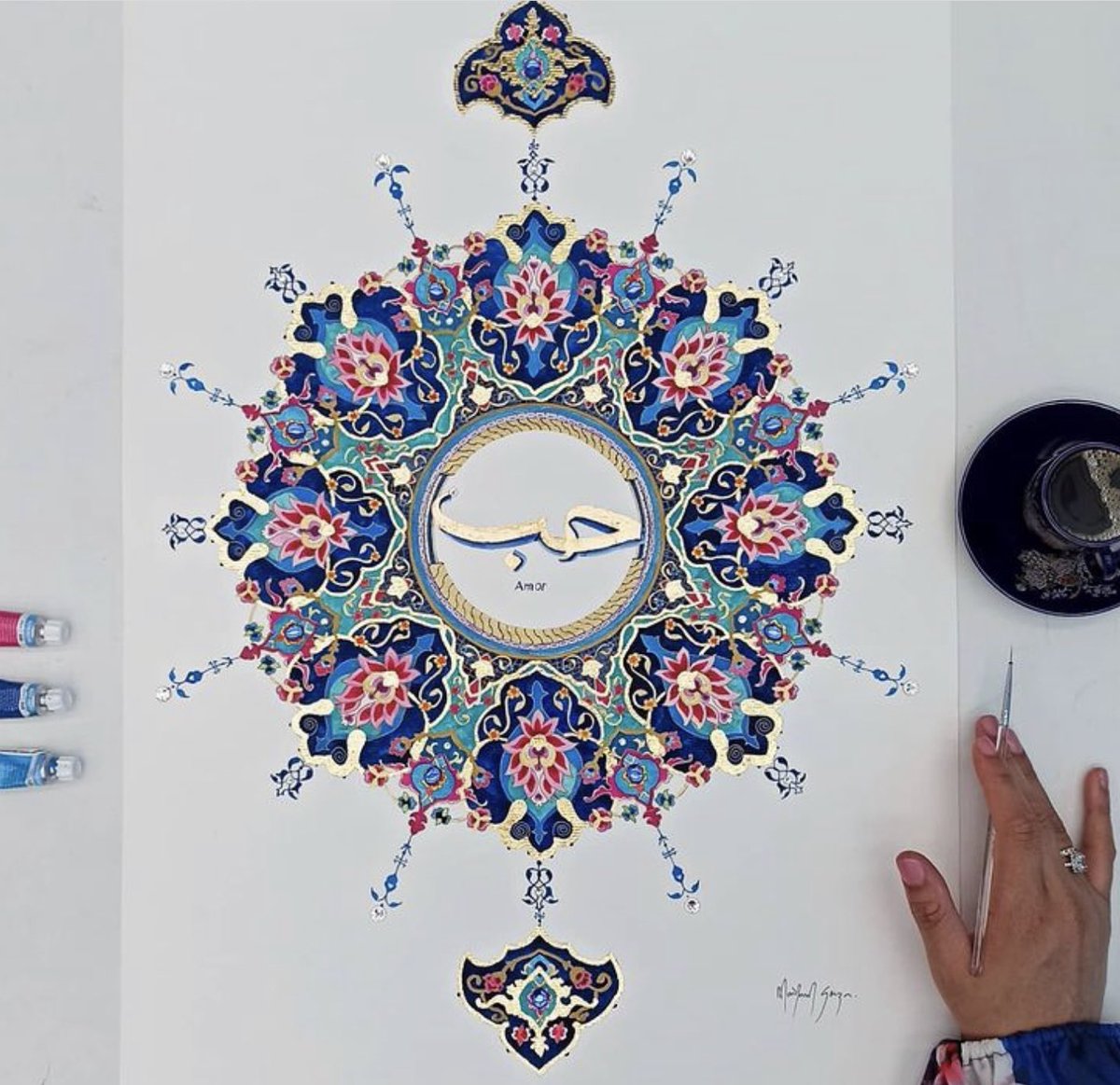Islamic illumination is a decorative art, that uses gold pigments to beautify the Qur’an & manuscripts, creating a spiritual awe & connection
Today, the art of Islamic illumination continues
For #Ramadan here are 18 women artists specialising in Islamic illumination
A thread…
Today, the art of Islamic illumination continues
For #Ramadan here are 18 women artists specialising in Islamic illumination
A thread…

1/ Artist & illustrator @AyeshaGamiet is based in the South East of England. Her work is inspired by the traditional arts & the beauty of nature. She was awarded an ijaza in Islamic manuscript illumination under Master illuminators in Istanbul:
baytalfann.com/post/aesthetic…
#Ramadan
baytalfann.com/post/aesthetic…
#Ramadan

2/ Japanese artist Yukiko Futamura has a passion for Islamic art & illumination. She studied Western calligraphy & manuscript illumination under artist Miwako Kawaminami for nearly 2 decades. Her work is influenced by Islamic cultures:
baytalfann.com/post/perspecti…
#Ramadan
baytalfann.com/post/perspecti…
#Ramadan

3/ Artist @RaanazShahid is from the U.K. Her work is influenced by her British, Asian & Islamic roots which have allowed her to create a unique aesthetic. She is studying the art of illumination with her Master hocam based in Istanbul:
baytalfann.com/post/redefinin…
#Ramadan
baytalfann.com/post/redefinin…
#Ramadan

4/ Maryam Souza is a Brazilian Muslim Islamic artist. She lives in São Bernardo do Campo, where one of the largest Muslim communities in Brazil is located. Her work is inspired by her Brazillian heritage, Islamic illumination & Qur'anic verses:
baytalfann.com/post/colours-o…
#Ramadan
baytalfann.com/post/colours-o…
#Ramadan

5/ Shafina Ali is a versatile creative Islamic artist whose paintings are inspired by masterpieces from Islamic history. She specialises in traditional Islamic art, writing verses from the Qur’an and Islamic illumination:
baytalfann.com/post/sacred-te…
#Ramadan
baytalfann.com/post/sacred-te…
#Ramadan

6/ South Indian artist Shadiya Mohammed is based in Kerala. Since childhood, she has been inspired by nature, which led to a passion for Islamic art. She trained in the art of Islamic illumination & is passionate about preserving tradition:
baytalfann.com/post/sacred-te…
#Ramadan
baytalfann.com/post/sacred-te…
#Ramadan

7/ Tehreem Pasha was born in Karachi & lives in Dubai. A geometer, trained calligrapher and specialist in Islamic illumination, she believes it is important to continue traditional arts for the future:
baytalfann.com/post/celebrati…
#Ramadan
baytalfann.com/post/celebrati…
#Ramadan

8/ Artist Rayhana K Haque trained as a counsellor, which she considers a privilege & an honour. However, her love for art began early on her childhood, and as an adult she found a connection to Islamic art, particularly Islamic illumination:
baytalfann.com/post/reviving-…
#Ramadan
baytalfann.com/post/reviving-…
#Ramadan

9/ Iranian artist, Anahita Alavi specialises in Persian Miniature & Islamic Illumination. She trained in the art of traditional painting under the supervision of a number of great masters in Iran:
baytalfann.com/post/persian-m…
#Ramadan
baytalfann.com/post/persian-m…
#Ramadan

10/ Whilst studying mathematics at university, artist @em_3190 found inspiration in Islamic geometry. After learning more about Islamic illumination, she developed a unique style bringing a contemporary twist to this traditional art-form:
baytalfann.com/post/talking-i…
#Ramadan
baytalfann.com/post/talking-i…
#Ramadan

11/ Bosnian artist Ailin Karić Plakalo has a passion for Islamic geometry, mandalas & illumination. The harmony, the beauty of the patterns, and the feeling that it evokes in her are the reasons why she started practicing Islamic art:
baytalfann.com/post/modern-ma…
#Ramadan
baytalfann.com/post/modern-ma…
#Ramadan

12/ Known for her ingenious use of colour & mastery of Islamic, biomorphic patterns & illumination, @EsraAlhamalArt is an artist & researcher based in London. Her work experiments & reinterprets traditional practices in contemporary ways:
baytalfann.com/post/illuminat…
#Ramadan
baytalfann.com/post/illuminat…
#Ramadan

13/ Canadian artist @oalanqar is inspired by Islamic illumination & indigenous art. She believes it is important for people to connect with their roots, & makes references to culture & heritage through her approach to traditional art:
baytalfann.com/post/forgotten…
#Ramadan
baytalfann.com/post/forgotten…
#Ramadan

14/ Saudi Artist Doa Bugis’s work is a poetic result of experimentation. Her art is influenced by painting traditions of China, Japan & South East Asia. A specialist in Islamic illumination, she is redefining this traditional artform:
baytalfann.com/post/stories-o…
#Ramadan
baytalfann.com/post/stories-o…
#Ramadan

15/ London based artist Mobeen Akhtar, specialises in the traditional arts. Her work takes you through a journey of colour and meticulous detail heavily inspired by traditional Islamic illumination:
baytalfann.com/post/preservin…
#Ramadan
baytalfann.com/post/preservin…
#Ramadan

16/ Artist Maram Ata’s Jordanian cultural heritage has inspired her practice. She has studied the traditional art of Islamic illumination & miniature painting and shares her thoughts on the future of Islamic art and culture:
baytalfann.com/post/the-art-o…
#Ramadan
baytalfann.com/post/the-art-o…
#Ramadan

17/ U.K based artist @fzhassan is an expert miniature painter trained in traditional Indo-Islamic, Mughal & Persian painting. Taking a modern twist on this tradition, she teaches & exhibits her work in galleries & museums:
baytalfann.com/post/reviving-…
#Ramadan
baytalfann.com/post/reviving-…
#Ramadan

18/ Originally from the Hejaz in Saudi, artist @saralabdali views herself as a caretaker of the region’s culture, preserving it against 4 decades of rapid transformation. She is committed to continuing traditional arts for the future:
baytalfann.com/post/sarahmoha…
#Ramadan
baytalfann.com/post/sarahmoha…
#Ramadan

• • •
Missing some Tweet in this thread? You can try to
force a refresh






















